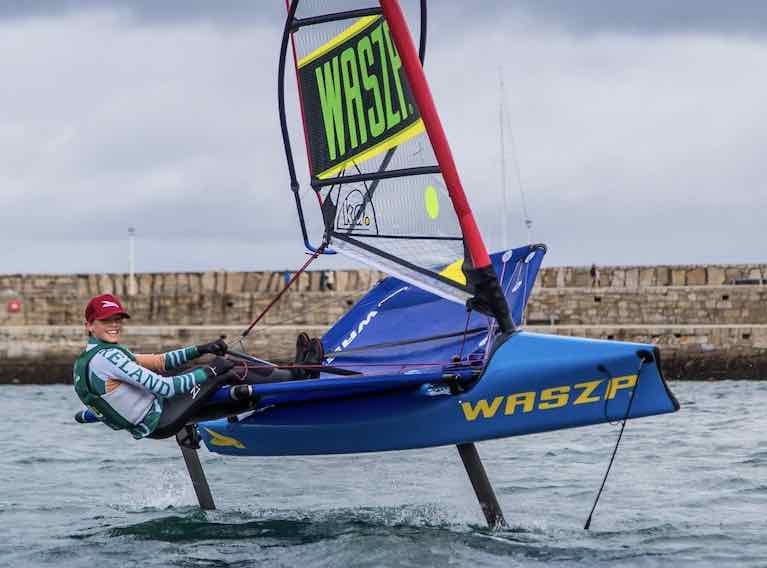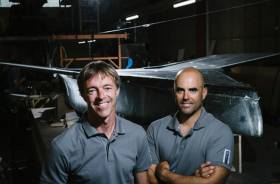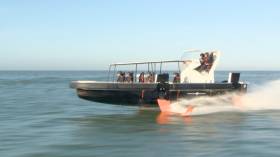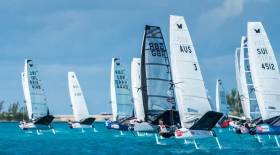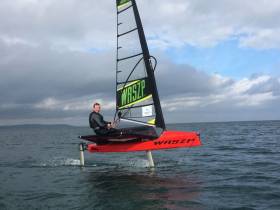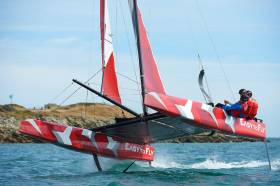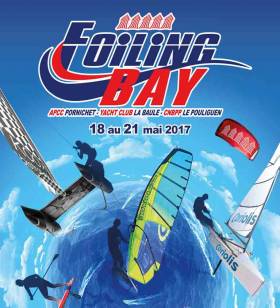Displaying items by tag: Foiling
New Sport of E Foiling Finds a Home on Strangford Lough
Rory Martin of the Strangford Lough Activity Centre provides a variety of land and watersports through what he says is a quirky, experimental adventure centre. Though the Strangford Lough bases are at Whiterock and Sketrick Island near Killinchy on the west side of the lough, it is very much a mobile facility available throughout Northern Ireland. But apart from what is probably considered a common set of sports including kayaking, paddleboarding, boat tours and wet bouldering, there is now e-foiling which Rory calls a Magic Carpet Ride – the next big development in water sports.
Once reserved as a Millionaires’ play toy, the new sport of E Foiling has found a home on Strangford Lough. Celebrities such as Amazon founder Jeff Bezos, big wave surfer Laird Hamilton or Facebook’s Mark Zuckerburg have tried it, with the latter going viral for flying above the water on an electric powered surfboard carrying an American Flag. This unique experience can be compared with driving a supercar or learning to fly a plane. For the same price as a night out, anyone can enjoy the feeling of flying above the water at speeds of up to 30mph.
E Foiling uses an electric powered surfboard on a hydrofoil wing which lifts 80cms out of the water giving an unparalleled experience of flying as Rory Martin suggests; “It’s like riding a magic carpet or a hoverboard. If you’ve seen Back to the Future, Disney’s Aladdin or indeed Marvel Comic’s Silver Surfer then you’ll have an idea of what to expect. We have purchased four of the Lift E Foils with the help of Ards and North Down Borough Council Experience Development Programme. Lift E Foils are considered the best available on the market. They are expensive pieces of kit, but we expect demand to be high and have received a huge amount of interest. The funding has allowed us to offer an introductory rate which should make it more affordable for the public”. He continues;” The latest technological advances that were once reserved for passenger ferries or high-end sporting competitions such as the America’s Cup are developing quickly. Powered by Lithium-Ion rechargeable batteries and using an all-carbon hydrofoil wing has allowed weight reduction and longer battery life with a flying time of two hours”.
Strangford Lough is an ideal location for e-foiling as there’s plenty of flat enclosed water and beautiful scenery. Furthermore, as a noiseless and pollution-less activity it is in keeping with the centre’s sustainable ethos. Rory is confident that it will be popular. “You don’t have to be a pro surfer to enjoy the activity. With some flexibility, most people can get up on the board on their first session. With all equipment provided including wetsuits, buoyancy aids and helmets, participants just need to turn up and give it a go”. Rory explains; “As we emerge from the pandemic, we expect the demand for newfound water sports to continue. Paddle boarding, kayaking and wild swimming have massively increased in popularity, and we have been instrumental in increasing access to the water. We expect demand tosurge but be warned! It is very addictive and some of our initial customers are already looking at purchasing boards. We are very proud to be the first people to offer it in Ireland”
Foiling Week Granted World Sailing 'Special Event' Status
World Sailing has awarded the upcoming 2022 Foiling Week Special Event status, ensuring the competition can grow, reach more people, and partner with international and national foiling programmes and pathways to create events within the event.
Foiling Week joins high profile activities with Special Event status such as the America’s Cup, The Ocean Race, SailGP, World Match Racing Tour, PWA World Tour, Star Sailors League and GKA Kite World Tour.
“Foiling Week is not just an event; it is a community and a network that is about action. We don’t only care about the foiling and greater sailing community,” said Luca Rizzotti, founder of Foiling Week.
“We create opportunities, with the goal in mind of being primarily agents of change. The event’s initiatives are well known in the sailing community and reach beyond the sport including partnerships with universities, manufacturers and non-profits in the environmental and social responsibility spaces. We are all connected and we should grow as a community, responsibly together,” added Rizzotti.
Foiling Week is the hub of the world hydrofoiling community and the only World Sailing Special Event that is community-based. It includes a well-attended Forum, where talented and creative individuals share ideas and collaborate to make connections and improve the way the event operates and the class evolves.
Special Event status ensures World Sailing formally recognizes and sanctions the events. It also means that Foiling Week will follow the targets set by the World Sailing's Sustainability Agenda 2030, which includes working with the Magenta Project to promote professional sailing opportunities for women, and the World Sailing Trust which provides funding for a diverse group of initiatives to increase access to sailing and promote sustainable practices in sport and manufacturing.
As part of the Charter, all Special Events have a comprehensive sustainability strategy, and aligned applicable principles as set out in the World Sailing Sustainability Agenda 2030, while committing to working with World Sailing to accelerate the objectives and targets.
David Graham, World Sailing CEO, said “The addition of Foiling Week to our group of Special Events is exciting for the future of sailing. The growth of the event has been phenomenal to witness, going way beyond the racing to galvanize an entire movement. We are pleased to be working hand-in-hand with them to create new avenues for partnership as well as opportunities to further the World Sailing Sustainability Agenda. Foiling Week has already taken great strides in this area and we are looking forward to learning from each other and inspiring a positive change throughout the sailing world.”
Foiling Week’s mantra is ‘connect, cooperate, change’. From the start, the event has been one of firsts. The first women’s and kids foiling trials; the first sustainability initiatives reducing entry fees for car-pooling participants and the elimination of single use plastics at the event site.
The SuMoth Challenge, part of every Foiling Week since its introduction in 2019, was shortlisted for this year’s World Sailing 11th Hour Racing Sustainability Award. A global challenge, it brought students from around the world together to design, manufacture and sail a sustainable Moth.
Having hosted events in Australasia, North America and Europe, Foiling Week has become a scalable, practical presence in sport both physically and online and is moving forward with World Sailing to connect, collaborate and make positive change in sport and beyond.
Royal St. George Waszp Sailor Charlie Cullen Wins Ireland's First Ever European Waszp Title
Royal St George sailor, Charlie Cullen, 19, is Waszp European Slalom Champion and Junior (U20) European Champion following this year's Waszp European Games in Lake Garda Italy.
Held in beautiful Circolo vela Arco, a competitive and experienced 87 boat fleet emerged representing 18 countries from around the world to fight for the 2021 European championship titles.
A month earlier Cullen, from Dalkey in Dublin, secured a Silver medal at foiling week in Malcesine with a thirty boat International fleet.
Day 1 and 2 of the European Games event saw the slalom competition in full force. The slalom event is a quick and fast downwind circuit, with races only lasting a few minutes. Before the finals, there were several heat events with each race being a knockout for those that finish outside the top five places.
In the very first race of the day, Charlie IRL 2987 almost found himself out, after capsizing in his first gybe. However, after a quick recovery, Charlie scrapped his way into the next round finishing 4th in a 3-way photo-finish with 4th, 5th and 6th.
 Charlie Cullen on the podium in Italy
Charlie Cullen on the podium in Italy
He managed to cruise his way through to the finals scoring 1st in both the quarter-final and Semi-final heats respectively. With a dying breeze, the finals were postponed to the following day.
After a 5 am wake up the Championship Fleet began racing for 5 hours in a 20 + knot north Peler wind that morning. Then after the fleet races, the top 10 slalom finalists gathered to race that afternoon in the famous Ora wind of Lake Garda.
Charlie, the only Irish to qualify for the finals - was on form winning the first race, with previous European slalom champion Elliot Savelon from the Netherlands hot on his tail.
However, Cullen, keeping his composure, finished 2nd and 3rd in the last two races of the final, thus scoring a 1,2,3 in the finals to become The 2021 Waszp European Slalom Champion.
The following days saw Championship Fleet racing unfold. With blistering temperatures, the famous afternoon Ora breeze of Lake Garda failed to fill in long enough for racing. This called the fleet again to an early 8 am first gun start for the 4 days of racing.
In the 20 knots of the morning Peler, and closing speeds of 30 – 40 knots the racing was quite a spectacle. The Waszp class standard has become higher and higher over the years resulting in extremely tight and exhilarating racing.
After winning the Slalom, he was one to watch in the battle for the overall title. Charlie port tacked the entire 87 boat foiling fleet resulting in a bullet becoming one of the many race winners. But with the tough conditions and tight crosses, he was struck with bad luck with a major collision with the helm of the other Waszp physically being flung through Charlie’s mainsail causing his sail to be written off and forcing him to miss two races of the day.
After getting redress, he was still in the fight for a top 10 overall and the Under 20 title. On the final day, he found his form getting a top 10 and a top 5 in the last races. This was enough for him to finish 10th overall and for him to be crowned the Waszp 2021 Under 20 Junior European Champion.
Matt Beck of GBR took the overall, with Germany’s Paul Farien and Italy’s Francesco Bertoni finishing the podium.
There was a strong Irish contingent, with six boats flying the flag. The young Irish fleet was represented by Royal St. George Sailors, Georgia Goodbody, Elysia O’Leary, Marcus O’Leary, Max Goodbody and Henry Start.
Three of the six boats received some top 10 results. With some incredible starting masterclasses from Marcus O’Leary and Max Goodbody who ported tacked the 87 boat fleet on multiple occasions. Max finished 30th, Marcus finished 39th overall and Henry Start finished 51st overall.
Georgia Goodbody and Elysia O’Leary both had a great event completing all the races in the tricky conditions. With Elysia finishing 64th and Georgia finishing second in the 6.9 category, 75th overall.
Full results are here
Dublin Bay WASZP Sailor Charlie Cullen Tops Global GPS Racing Series
Dun Laoghaire Harbour WASZP sailor Charlie Cullen is in pole position to win the first prize of two spectator tickets to a Sail GP event and a ride on an F50 catamaran following his own foiling exploits in the class’s global GPS racing series.
WASZP sailors, including Cullen, have been competing over an event window from September 14th – October 12th and the Dublin Bay teenager is currently top of the rankings with just three days left to sail.
The beauty of this initiative by WASZP is that sailors from every corner of the globe can race against each other and continue to compare themselves against the best. This, say the promoters, is using the best aspects from windsurfing and kitesurfing and integrating it into the more traditional racing/event formats.
 Waszp Sailor Charlie Cullen with his top speeds recorded by GPS
Waszp Sailor Charlie Cullen with his top speeds recorded by GPS
Because of the nature of the event, sailors are not scored just on the fastest speed. The sailors are scored on three categories:
- Average top speed
- Best 250m run
- Total distance sailed in 1/2 an hour (calculated off your average 1/2 hour speed.)
Charlie's winning runs clocked the following:
- Sailed a total distance of 52km
- Max 2sec at 24.53 knots.
- Half hour average speed of 16.01 knots
Will this be the winning time by the deadline?
More details on his rise to the top here
Besides the strong third-place showing by David Kenefick on Lake Garda a week ago, International Foiling Week also saw the launch of a new two-person foiling dinghy.
The NTFM Syra 18 is the brainchild of America’s Cup winners Niels Frei and Yves Detrey, and is being touted as the first double-handed monohull foiling dinghy.
Its design concept hinges on a canting T-foil system, and an innovative hybrid monohull shape to keep the boat stable at low speeds and in no-foiling mode. The aim is to dispel the notion that foiling is technically demeaning and carries higher risk than traditional sailing.
Indeed, its creators say the design’s key principles (see below) will ensure that the NTFM Syra 18 will be accessible to the widest possible range of sailors through its combination of simplicity, versatility and stability with blistering performance potential.
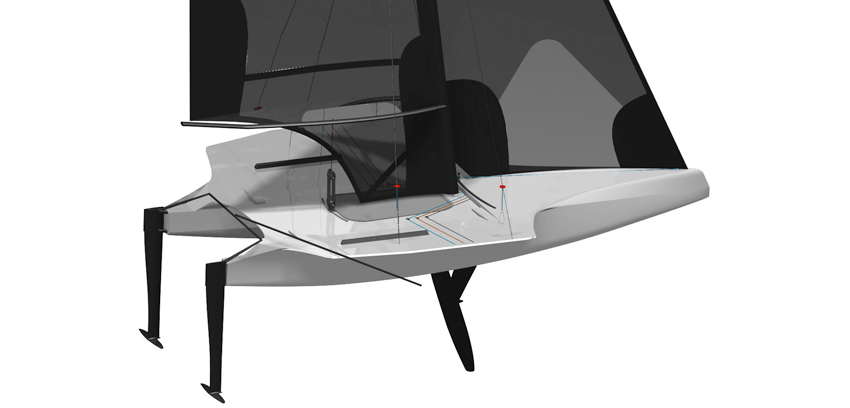
The team behind the NTFM Syra 18 have been sailing all their lives and have impeccable credentials. Nils Frei and Yves Detrey are two-time America’s Cup winners with Alinghi, and have competed consistently at the highest level on the D35 and GC32 circuits.
“I have been addicted to foiling ever since my first flight,” Nils says. “There are two aims with the NTFM Syra 18: to offer the best experience of foiling flight to the widest possible range of sailors regardless upon experience and ambition; and, to produce a boat suitable for Olympic competition.
“We are fortunate to have been supported in our ambitions by our partners Isabelle Rinsoz and Publiaz, both of whom have been real assets.”
Yves adds: “When we first hatched the idea, we knew we had to prove the concept before launching in the marketplace and to make sure our aims were realistic. We wanted buyers to have the best possible experience from the moment of purchase and for the boat to have the potential to enhance sailing at the Olympics.
“We are close to reaching that point and are looking forward to getting the first production boats in the water.”
The initial design drawings for the NTFM Syra have been produced by VMG Yacht Design in Lausanne. And the first boat to be launched will be named SYRA by Publiaz, after NTFM’s main partner.
The boat will be tested and optimised, taking part in some classic races primarily in the western part of Switzerland where Publiaz has its main business focus. Thanks to Publiaz’s engagement, NTFM Syra will be able to prepare the launch of the production models in an optimal manner.
Key Design Principles
Safety
The hybrid hull shape means to boat is stable at low speed and in no-foiling mode, making leaving and returning to shore a safe proposition in light or even gusting conditions. With one central T-foil in the water, there are no sharp, trailing edges above deck-height reducing the risk of physical harm. The double rudder configuration adds stability and their position beneath the hull wings greatly reduces the risk of injury when falling overboard. Finally, the hull shape and foil configuration offer a number of set-ups which will enable the NTFM Syra 18 to be sailed by a broad range of experience, weight and age. While the most experienced will be ready to foil straight off the beach, less-experienced sailors will be able to grow into the boat taking steps that increase speed and excitement as and when they are ready.
Efficiency
The hybrid monohull shape is low-drag and the deck-sweeper mainsail is highly efficient. The main canting T-foil and the double rudder system, which offers the possibility to apply differential, means significant righting-moment with or without use of the optional trapeze. Dynamic adjustment of the main T-foil makes depowering sails in gusts unnecessary. Trimming the foil allows power to be kept on, promoting acceleration on a stable, reassuring platform. Flight height is regulated by a proven mechanical wand system. Changeable foil tips promote optimisation in a range of conditions and the single central foil makes tacking and gybing straight-forward. Mainsheet location is behind the deck sweeper and the curved traveller rail will allow for easy trimming. The set-up is completed by a self-tacking, furling Code 0.
User-friendly
The NTFM Syra 18 is highly versatile, offering safe, efficient sailing in a wide range of wind conditions for a broad spectrum of sailors. Waterproof pockets and deck window to see foil operation enhance the experience. Launch and recovery are facilitated the retractable rudders and main foil. Foldable wings minimise boat park requirements and mean the boat fits on a standard 2.20m-wide road trailer.
Beneteau Unveils Its First Motor Foiling Yacht
Groupe Beneteau has followed up its first foiling sailing yacht in the Figaro Beneteau 3 with a concept for a motorised version.
Working with partners DEMS Sarrazin Design, Noval and SEAir, the “next generation flying boat” was created over a nine-month period, resulting in an “outstanding” design its makers say both improves performance while reducing fuel consumption.
Key to its design are its pivoting foils, which enable the boat to be used with or without foils, without any loss of output on the water — while the boat takes up the same space in port as an equivalent without foils.
The prototype took to the water for tests earlier this month at Saint-Gilles-Croix-de-Vie, with its results supporting the case for the use of foils with motor yachts.
“Following the Figaro Beneteau 3 for sailing, Groupe Beneteau is once again demonstrating its capacity for innovation with this first motor foiler,” said Hervé Gastinel, Groupe Beneteau chief executive.
BJ Marine are the Irish agents for Beneteau Boats, whose Barracuda range was recently displayed at the Ireland Angling show in Dublin.
Setback for Foiler Rory Fitzpatrick in Race Two of Moth Worlds, David Kenefick Lying 14th
Dublin foiling supremo Rory Fitzpatrick did not start the second race of the Bacardi Moth World Championship in Bermuda yesterday when 30–knot gusts hit the 33–boat fleet. It means the National Yacht Club and Royal Irish Yacht Club sailor now lies 24th overall some ten points adrift of countryman David Kenefick of Royal Cork Yacht Club who mastered both blustery races to count a 17 and 13 to be fourteenth overall, just seven points outside the top ten. Full results are here
Goodison Takes Lead
Paul Goodison of the U.K. took the early lead after winning the first two races on Great Sound.
Hosted by the Royal Bermuda yacht Club, the world championship got underway a day late after yesterday was blown out. Yesterday was on the hairy edge as the wind blew steadily between 18 and 22 knots with gusts nearing 30 knots. The conditions were challenging for the sailors but left some exhilarated.
Goodison didn't suffer any breakdowns today but one of his main rivals, Iain Jensen of Australia, did. Jensen led Goodison around the first lap of Race 1, heightening the intrigue as to which of the veteran Mothists is faster.
On the second upwind leg, however, Jensen's boom vang broke. He managed to salvage a fifth in the race but then missed the second race because he returned to shore to make a repair in the hopes of returning for the third race. By that point the wind had increased and the race committee decided to postpone the rest of the day's schedule.
Racing is scheduled to continue tomorrow with a forecast that calls for winds of 12 to 20 knots.
Bacardi Moth World Championship Bermuda Provisional Standings
(After 2 races)
1. Paul Goodison (GBR) 1-1 - 2 points
2. Brad Funk (USA) 3-3 - 6
3. Rome Kirby (USA) 7-2 - 9
4. Simon Hiscocks (GBR) 2-8 - 10
5. Victor Diaz de Leon (USA) 4-6 - 10
6. Dan Ward (GBR) 6-5 - 11
7. Benoit Marie (FRA) 8-4 - 12
8. Francesco Bruni (ITA) 13-7 - 20
9. David Holenweg (SUI) 9-12 - 21
10. Michael Barnes (GBR) 12-11 - 23
Want To Learn To Foil? Check Out This New Survey
#HowToFoil - Waszp agent John Chambers has launched a survey to gauge public interest in learning to sail foiling dinghies this year.
As previously reported on Afloat.ie, National Yacht Club member Chambers brought the Waszp to Ireland last year after pioneering Moth sailing at Dun Laoghaire’s waterfront.
The Waszp was devised as an answer for dinghy sailors who didn’t quite feel comfortable with the standard International Moth.
Now Chambers is attempting to determine how many people are actually interested getting to grips with a Waszp on the water via a short online survey available HERE.
New Foiling Catamaran Is ‘Easy To Fly’
#Foiling - Orders are flying in for a new design foiling catamaran, according to its French makers.
Easy to Fly is the brainchild of solo sailor Jean-Pierre Dick, who placed fourth in the most recent Vendée Globe, and Guillaume Verdier, designer behind the new foiling One Design monohull chosen for future editions of the Volvo Ocean Race.
The 26ft multihull is designed to fly safely from a wind speed of 8 knots with three people on board — and is likely to be a future fixture on a French sailing scene that’s fully embraced foilingfoiling as a discipline.
Launched in September 2016, sales for Easy to Fly are up to six across Europe — including one to England, to the team behind the Open7.50 Cool Runnings, who will take delivery of their boat next week.
Foiling is in right now. And with Olympic hero Annalise Murphy leading the Irish charge in the relatively new class, there’s never been a better time to get on board and get flying on foils.
Visit www.EasyToFly.fr for more.
French 'Foiling Festival' Starts Today
Running from today to Sunday 21st May, Pouliguen Bay - La Baule - Pornichet will host the second edition of the Foiling Bay, a spectacular event that celebrates the foiling phenomenon. This year the Foiling Bay, La Baule’s newest Derby, will host not one but five foiling disciplines in its nautical arena, which is ideal for sailing foiling boats and boards: Flying Phantom, Foiling Moth, Kitefoil, Foiling Windsurf and Foiling Stand Up Paddle, all new boats and boards that represent the future of water sports. There is no need to be a specialist to enjoy this highly aesthetic and sensational show. This year the event is merging with the legendary Derby Kite and Paddle, a staple of the Stand Up Paddle circuit since the advent of this sport in which the best kite-surfers usually compete.
High flying competitions
Thanks to the appearance of foils (large fins which, similar to that of an aircraft wing, with added speed allows the support on which they are fixed to be lifted off the water), the new generation of boats no longer float but fly and reach impressive speeds.
Organised by three of the main clubs in the bay, the Cercle Nautique de La Baule le Pouliguen Pornichet (CNBPP), the Yacht Club de la Baule (YCLB) and the APCC, the Foiling Bay will gather more than one hundred competitors of 9 different nationalities for four days.
The event proposes an ambitious programme, and the level promises to be first class with four stages of the national and international professional circuits: the Warm Up of the European circuit of the Flying Phantom Series, the final regatta of the Brittany Moths Series, the Neilpryde Series - CRX Kite and the Neilpryde Series - RSX convertible to board.
The first three days will be dedicated to technical regattas and the Bay Derby (inshore raid linking the 3 clubs), while Sunday will be dedicated to a knockout speed event, the spectacular “King of the Bay” trophy. Who will sail the highest off the water?
“The Foiling Bay will be the first official event of the convertible RSX monotype concept. We wish to promote this new futuristic windsurfing board in order for it to reach the Olympic Games of 2024. I am very happy that this event is taking place in my homeland in La Baule Bay, there is no doubt it is going to be a wonderful event!” Julien Bontemps, Olympic windsurfing vice champion.
“I am very pleased that the Foiling Bay is being held in the bay of La Baule. This is the first time in the world that we will see so many foiling boats on the same start line. The level of performance is going to be exceptional and the waters of the bay are very suitable for foiling boats. I am looking forward to the first start with my co-pilot JB Gellét!” Sébastien Rogues, ENGIE Sailing Team skipper.
The first global Foiling Stand Up Paddle event
This new edition of the Foiling Bay is all the more important, as it will host the world's first Foiling Stand Up Paddle event. The newest addition to the board-sports family, this discipline attracts all the thrill-seekers. This board is equipped with a foil, that allows the competitors to propel themselves over the water with the aid of a paddle. Whether in the waves or in the offshore swell, the Foiling Stand Up Paddle can reach thirty kilometres per hour and is definitely a new popular discipline.
Spectator zones on the water for increased safety
The new ultra fast foiling boats also require greater vigilance. Therefore, for the safety of all, the maritime prefecture has decreed an exclusion zone. This area will be marked and there will be numerous organisers’ boats on the water to help prevent sailing in the area.
Spectator zones will be arranged so that the greatest number possible can come to admire the regattas safely on the water.
Onshore entertainment
With an entertainment village open to the public, the Foiling Bay promises to offer a great show both on the water and ashore. Located on the beach, in front of the Yacht Club de La Baule, the village is the hub of participants and spectators and is the perfect place for sharing and making new friends.. The regattas will be broadcast live and have live commentary in the midst of many activities accessible to all, enabling children and adults to learn about this latest generation flying machines.
Committed partners
This unique event has been made possible thanks to the contribution of enthusiastic sponsors. The first of these, Coriolis Telecom, a committed partner of the Derby Kite & Paddle, has furthered its confidence in the organising team by lending its support over the next two editions thanks to their strong commitment to innovation and modernity.
“I am very pleased that Coriolis is the main sponsor of this new and magnificent adventure of the Foiling Bay which is a world first. Coriolis is speed, it is surfing on the web, it is freedom, it is the wind, it is energy, it is audacity, and it is passion and also friendliness and respect. We therefore share the same values with the Foiling Bay team . There is nothing better than to combine the Atlantic breeze and human sporting adventure with Coriolis on one side and Foiling on the other.” Pierre Bontemps, Founding President of Coriolis.
The Pays de La Loire Region, also a partner of the event, reveals great ambitions as to the practice and promotion of foiling in the region, where the coastal waters are particularly adapted and suitable for these nautical disciplines of the future.
“A large nautical territory, but also a land of innovation, the Pays de la Loire Region is proud to see new disciplines on its coastline reflecting our values: boldness, determination, innovation and team spirit.” Bruno Retailleau, President of the Pays de la Loire Region.





























